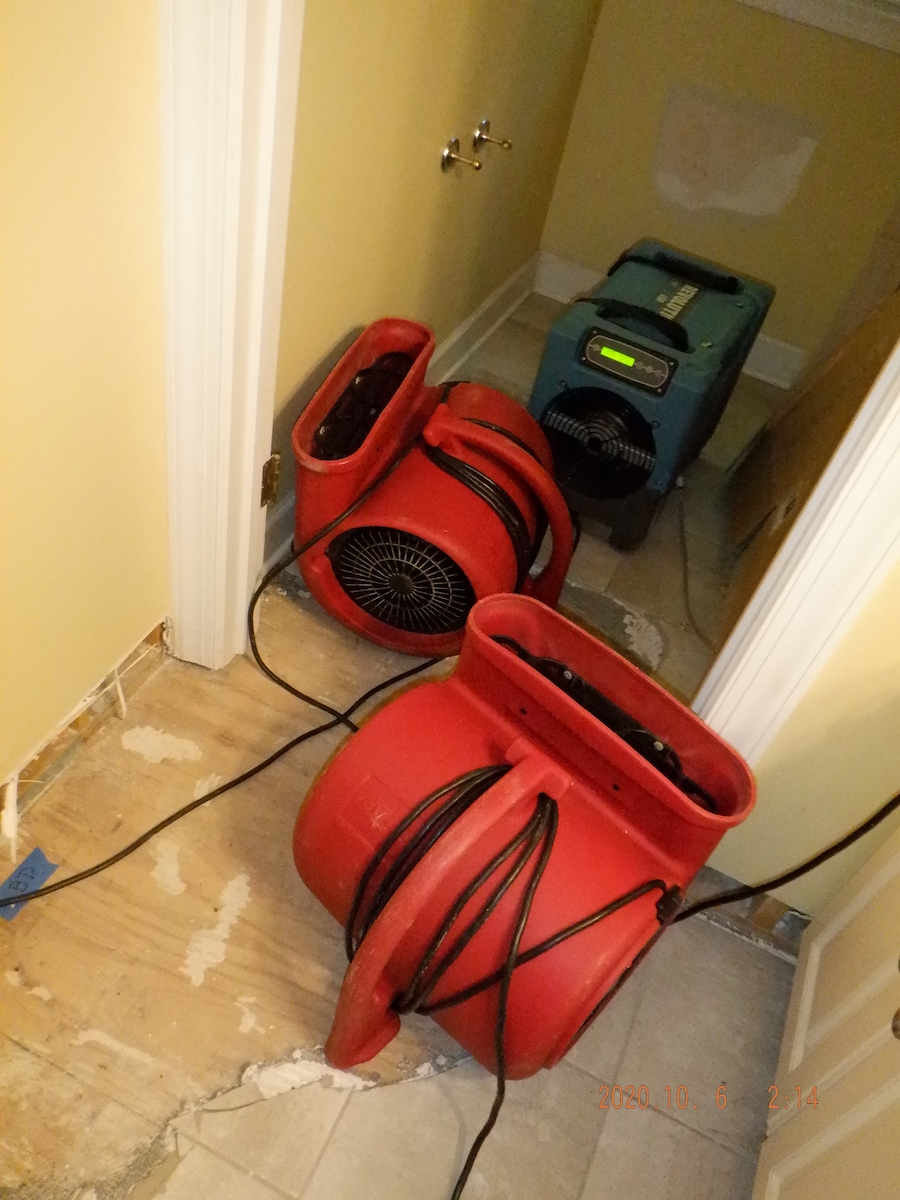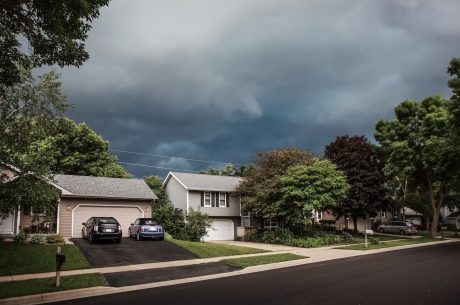A flooded bathroom is more than a messy inconvenience—it’s a health and safety concern. Whether caused by an overflowing toilet, burst pipe, or heavy storm, standing water can lead to mold, bacterial contamination, and costly structural damage.
In this guide from PuroClean Disaster Response Services, serving Apex, Cary, Holly Springs, Morrisville, and Raleigh, you’ll learn how to clean a flooded bathroom safely, when to call professionals, and how to prevent future water damage.
What to Do First
If your bathroom floods, acting quickly is the best way to minimize damage. Here’s how to clean a flooded bathroom safely and effectively:
- Turn off the water and electricity: Locate the main water shutoff valve and stop the flow immediately. If water is near outlets or fixtures, switch off power at the breaker box to prevent electrical hazards.
- Remove as much standing water as possible: Use towels, a mop, or a wet/dry vacuum to extract excess water right away. The longer water sits, the more it seeps into floors, walls, and grout lines.
- Disinfect all affected surfaces: After removing the water, clean floors, walls, and fixtures with a disinfectant or a diluted bleach solution to eliminate bacteria, especially if the floodwater came from a toilet or drain backup.
- Dry the area completely: Run fans and dehumidifiers for at least 24–48 hours to pull moisture from the air and surfaces. Proper drying helps prevent mold growth and lingering odors.
- Check for hidden moisture or mold: Even after visible drying, moisture can remain behind tiles or under flooring. Look for soft spots, peeling paint, or musty smells—signs that you may need professional help.
If the water looks dirty, cloudy, or smells foul, it may be contaminated. In that case, avoid direct contact and call a certified restoration company that knows how to clean a flooded bathroom safely and thoroughly.

Your bathroom could be flooding due to a leak, so the first step is to turn off the water supply.
Safety Steps Before Cleaning a Flooded Bathroom
Floodwater is unpredictable. Even clean-looking water can hide bacteria, chemicals, or electrical hazards. Before you begin cleanup, make sure the area is safe.
Start by shutting off the main water supply to stop additional flooding. If outlets or light switches are near the waterline, cut power to the bathroom from your circuit breaker to avoid electrocution.
Next, protect yourself. Wear rubber gloves, waterproof boots, and an N95 mask to avoid direct contact with contaminants or airborne spores.
Once it’s safe, open windows and doors to circulate air. Good ventilation helps dry the space faster and slows down mold growth, which can begin within 24–48 hours.
Finally, take photos or short videos of the damage. This quick documentation step is often essential for insurance claims and restoration quotes.
How to Clean a Flooded Bathroom
Once the bathroom is safe to enter, you can begin the cleanup. These steps apply to clean water (from pipes or rainwater). If you suspect sewage or gray water, contact professionals right away.
Start by removing any standing water using a wet/dry vacuum, sump pump, or mop and bucket. Towels can help soak up smaller puddles, but be sure to discard them afterward—floodwater isn’t sanitary. Avoid using household vacuums, as they aren’t built for water and can be dangerous.
Next, remove soaked fabrics and items that can’t be sanitized, such as rugs, cardboard boxes, and toilet mats. Towels and washable fabrics should be laundered in hot water with detergent.
With the area cleared, disinfect every hard surface: floors, walls, toilets, sinks, and fixtures. A simple bleach solution—one cup of bleach per gallon of water—kills most bacteria and viruses. Apply the solution, scrub gently, allow it to sit for 10 minutes, then rinse thoroughly with clean water.
Once cleaned, focus on drying. Run fans and dehumidifiers for at least two to three days, keeping doors and cabinets open to encourage airflow. Check corners, grout lines, and under sinks for lingering moisture. Even small damp spots can lead to future mold problems.
Preventing Mold After Bathroom Flooding
Mold is one of the biggest post-flood threats. It can begin forming in as little as 24 hours, especially in a warm, humid space like a bathroom.
After the area is dry, inspect carefully for discoloration, fuzzy patches, or musty odors—these are early signs of mold. Clean small spots using a mold-killing cleaner or diluted vinegar solution, but if you find widespread growth, contact mold remediation specialists to prevent spores from spreading through the home.
Even if mold isn’t visible, prevention is key. Apply a mold inhibitor spray to tiles, grout, and drywall. Natural options like white vinegar work well on most surfaces. Continue using dehumidifiers for several days to remove residual moisture.
If materials such as drywall, insulation, or ceiling tiles were soaked, replace them rather than attempting to clean. According to the Environmental Protection Agency (EPA), materials that stay wet for over 48 hours can develop hidden mold and should be removed entirely.
Maintaining ventilation is just as important as cleaning. Keep exhaust fans running after showers and use portable dehumidifiers in bathrooms prone to humidity. This ongoing airflow discourages moisture buildup and future mold growth.

Even after cleaning, moisture can linger, creating a haven for mold and mildew.
Repairing and Restoring Water-Damaged Bathroom Fixtures
Once the bathroom is dry and clean, inspect fixtures and finishes for damage. Sinks, toilets, and bathtubs made of porcelain or metal often survive floods, but wood cabinetry and laminate vanities may warp or swell.
If you notice leaks or corrosion on pipes and connectors, schedule an inspection with a licensed plumber. It’s common for plumbing joints to loosen slightly during flooding, which can cause slow leaks later.
Walls and flooring may also need attention. Replace any softened drywall and repaint using mold-resistant paint. Reseal grout lines around tiles and use waterproof caulk to prevent water from seeping behind walls again.
For long-term protection, consider installing water sensors or automatic shut-off valves that detect leaks early. These small devices can save thousands in potential water damage repairs.
When to Call a Professional
While small, clean-water spills can often be managed with household tools, larger or contaminated floods call for expert help. Knowing how to clean a flooded bathroom safely means recognizing when the situation is beyond DIY efforts.
If the water source involves sewage, if it’s soaked into walls or flooring, or if mold appears within 48 hours, don’t attempt to fix it alone. Professional restoration teams, like PuroClean Disaster Response Services, use specialized moisture meters, HEPA filtration, and industrial dehumidifiers to extract water completely and safely sanitize your home.
We also help with insurance documentation and full structural drying, ensuring your bathroom returns to a safe, pre-loss condition quickly.
DIY Cleanup vs. Professional Restoration
Here’s a quick comparison to help you decide which approach is right for your situation:

If you’re unsure of the contamination level, always err on the side of caution and call for a professional inspection.
Contact PuroClean Disaster Response Services for Expert Help

PuroClean has industrial-grade tools needed for severe flooding issues.
Flood damage can escalate quickly—but with the right response, it doesn’t have to.
At PuroClean Disaster Response Services, our IICRC-certified technicians provide fast, reliable water damage restoration and mold remediation throughout Cary, Apex, Holly Springs, Morrisville, and Raleigh.
Call us 24/7 at (919) 481-4600 or visit our website to schedule an inspection. We’ll restore your bathroom—and your peace of mind—safely, efficiently, and professionally.
FAQs About Bathroom Flood Cleanup
Q1: How long does it take to clean and dry a flooded bathroom?
Drying typically takes two to three days, depending on how much water was absorbed. Hidden moisture under floors or behind walls may take longer to remove. Professionals who know how to clean a flooded bathroom properly use moisture sensors to ensure everything is fully dry.
Q2: Can I use bleach when learning how to clean a flooded bathroom?
Yes—mix one cup of bleach per gallon of water to disinfect hard surfaces. Always ventilate the space, wear gloves, and avoid mixing bleach with other cleaners.
Q3: How do I know if the floodwater is contaminated?
If the flooding came from a toilet, sewer line, or storm drain, it’s considered contaminated. In those cases, don’t attempt how to clean a flooded bathroom on your own—call a professional restoration service immediately.
Q4: Does homeowners insurance cover flooded bathroom cleanup?
Coverage depends on the cause. Burst pipes and appliance leaks are usually included, while rainwater or storm flooding often requires separate flood insurance.
Q5: How can I prevent another flooded bathroom?
Inspect plumbing regularly, clear drains and traps, and consider installing water alarms or automatic shut-off valves to catch leaks early.



